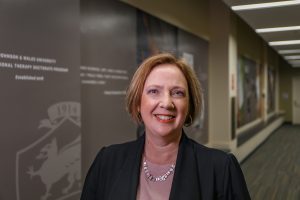By: Shannon Strate, OTD, MS, OTR/L, Assistant Professor at Johnson and Wales University, UDL Teaching Fellow, Goodwin University
While participating in Goodwin’s University’s Universal Design for Learning Institute, I chose to focus on the design of an Occupational Therapy (OT) neuroscience course, OTD 7210.
The breadth and depth of material covered in this foundational course has a history of being presented to students primarily via lecture. Despite the lecture format, students still play a crucial role in their learning journey. They are responsible for completing challenging chapter readings before class, and although I try to focus the reading on select pages, I am often told it is overwhelming.
This student feedback has been instrumental in shaping and reshaping my teaching methods.
Promoting active learning through UDL
When assessing OTD 7210 to determine which UDL checkpoints I was already implementing, I noted that I use active learning tools to recruit interest (UDL Checkpoint 7.3) by integrating videos within the class and for supplemental support.
I also provide anatomy coloring pages for the topic we are discussing to help students establish a visual connection to the material. I regularly use various methods to self-regulate the students and myself, such as fun rating scales of their mood, adjusting lighting, and movement breaks.
Challenges of traditional course design
As with any self-critique, the barriers are easier to identify, which motivated me to choose this course as my focus.
OTD 7210, traditionally designed with lectures, relies heavily on summative evaluative measures — leading to a breakdown in students’ engagement with and learning the material, as they are too focused on memorizing components from the lectures and readings (UDL Checkpoints 8.1, .2, .4).

The long lectures and readings make it easy for students to become lost in the material and lose the connections to what is important (UDL Checkpoint 3.2). In addition, the medical terminology is vast, and the pronunciation of terms is challenging (UDL Checkpoint 2.2). Finally, students struggle with planning and problem-solving when faced with unfamiliar information (UDL Checkpoint 6.2).
Implementing UDL strategies to improve learning
Goodwin’s UDL Institute has enlightened my outlook on this neuroscience course. I have implemented several engagement initiatives, including the addition of several formative, low-stakes quizzes (UDL Checkpoint 8.1). I also use weekly skill checks in an exam format, which are ungraded but provide feedback with instant results (UDL Checkpoint 8.4).

I have added a main notes document so students can listen during class and not feel they need to take as many notes (UDL Checkpoint 8.2). I also introduced concept mapping and encouraged students to use it to understand the systems and examples provided in class (UDL Checkpoint 3.2). The biggest change was incorporating weekly cases with questions to guide chapter readings (UDL Checkpoint 6.2). Now, the students have a real-life scenario to apply the concepts and facilitate discussion in class.
The positive impact of a UDL classroom
My appreciation for this neuroscience course has changed dramatically due to the Goodwin University UDL Institute. I am deeply grateful to my students for their openness and willingness to adapt to these changes. This semester, I have been transparent with them about making changes and seeking their opinions. I have already received positive feedback from students about the new cases and quizzes. Their feedback is invaluable and has guided me in refining my teaching methods.

The UDL framework is a guidepost for occupational therapists as we seek universal design and accessibility in so many aspects of our work with clients. It can be challenging in higher education systems and professional standards when student learning is culminated by an exam. Although I cannot change the result, I certainly can use the UDL framework to engage students through multi-modal representations of learning. Activating students’ planning, self-regulation, and problem-solving skills will enhance their critical thinking for future learning.
At Goodwin University, we’re leading the charge in bringing UDL to higher education — helping faculty and staff from colleges and universities across the globe remove learning barriers to foster accessible, flexible, and inclusive learning experiences. Learn more about the Goodwin University Universal Design for Learning Institute, or contact Diana LaRocco, Ed.D., at gili@goodwin.edu to explore how you can bring UDL expertise to your classroom.

Shannon Strate, OTD, MS, OTR/L
Shannon is an Assistant Professor teaching in the occupational therapy doctoral program at Johnson and Wales University in Providence, Rhode Island. Shannon has been an occupational therapy practitioner in Rhode Island since 1999, working with individuals with disabilities and older adults in short-term rehab and long-term care facilities. She has many years of experience as a rehab manager in skilled nursing facilities, leading the occupational, physical, and speech therapy staff while collaborating with interdisciplinary teams.
References
CAST (2018). Universal Design for Learning Guidelines version 2.2. Retrieved from http://udlguidelines.cast.org.
Goodwin University is a nonprofit institution of higher education and is accredited by the New England Commission of Higher Education (NECHE), formerly known as the New England Association of Schools and Colleges (NEASC). Goodwin University was founded in 1999, with the goal of serving a diverse student population with career-focused degree programs that lead to strong employment outcomes.

